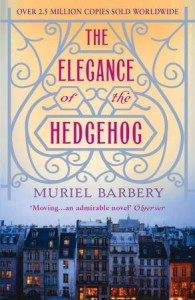
 Book review: The Elegance of the Hedgehog
Book review: The Elegance of the Hedgehog
One of the issues I end up debating quite a lot with other writers, and with readers too, is whether it’s better to read an ambitious book that’s flawed, or a flawless book that’s pedestrian in scope. And of course the question, in part, depends on your definition of ‘ambitious’ and ‘flawed’.
I would use both words to describe The Elegance of the Hedgehog by Muriel Barbery, published by Gallic and excellently translated (as far as I can tell) by Alison Anderson. This is a fiercely French novel, in the best possible senses: it’s rich with ideas, highly textured, focused on the value of the lived life and clearly posits the idea that philosophy should not just be a subject of study, but an element of everyday life. The unapologetic way in which Ms Barbery condemns people who live banal lives is refreshing – and when her two protagonists indulge in the quiet luxuries of thought and observation she manages to make us share in their belief system.
In my view though, the book is still flawed, as many ambitious books are. While it may be a personal prejudice, I found her preteen protagonist Paloma to be unlikeable and unpleasant. On the other hand, Renee the fifty-something concierge who has ‘the elegance of the hedgehog’ (ie she conceals her autodidactic profundity behind the imbecilic front that is superficially the uniform of any Parisian concierge) is quite delightful and rewarding to experience, right up to the moment when she experiences a ‘life-shock’ of the kind that the average therapist dreams of delivering, and is apparently set free of her inferiority complex by a simple sentence spoken by the rich and worldly Mr Ozu who has recently moved into the building she looks after. At which point this reader felt she’d moved from the reading lectern in a forbidding French library to the couch with Oprah. And the ending is simply sentimental. I won’t spoil it, but brace yourself for an Amelie moment.
So would I recommend it? Unreservedly yes – while it’s definitely a French pastime to write intellectual books for the masses (Alain de Botton has done well enough from it) such books often lack the charm that this one has in copious dashes. And when Barbery is good, she is very good indeed, eg when thinking about the difference between European doors and Japanese sliding ones, Renee muses ‘I was fascinated by the way the Japanese use space in their lives, and by these doors that slide and move quietly along invisible rails, refusing to offend space. For when we push open a door, we transform a place in a very insidious way … a door disrupts continuity without offering anything in exchange other than freedom of movement’. It’s exactly this kind of potted intellectual exercise that has had some critics foaming, but I think potted exercise is better by far than none and all and I’d take a hundred books like this (were they on offer, which, sadly, they currently are not) over all the grimly realistic, reductionist, Carveresque offerings that currently dominate popular literary culture.
A final word. The cover of this paperback is simply divine. If you have ever sat on a train, looking at the lighted windows of houses along the track, pondering the flashes of life that you see from your vantage, the illustration alone is enough to give you hours of pleasure. I am rarely won over to books simply by their covers, but in this case the perfect harmony between content and image is remarkable and noteworthy. There appear to be two covers on offer – make sure you get the one I’ve featured, it provides your money’s worth, almost before you open the book!


1 Comment
Martin Heavisides
2nd January 2010Very solid review, Kay. I’m posting a comment here rather than (or as well as) on Zoe since when I post links to my blog on Zoe, the comments tend to turn up there and my blog remains pristine and reft of comment.